Jammu - City of Temples
Jammu, about this sound pronunciation also known as Duggar, is one of the three administrative divisions within Jammu and Kashmir, the northernmost state in India. Jammu city is the largest city in Jammu and the winter capital of Jammu and Kashmir. Jammu City is also known as "City of Temples" as it has many temples and shrines, with glittering shikhars soaring into the sky, which dot the city's skyline, creating the ambiance of a holy and peaceful Hindu city.
HILL STATIONS IN JAMMU
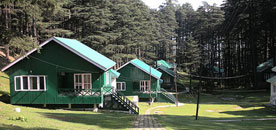
Patnitop :
Relatively unknown, compared to the other tourist spots in the state Patnitop is no less beautiful or serene. With all its beauty at a hill station, it is a charming plateau at 2,024m. The meadow is surrounded by dense woods and lush greenery of Pines. Visiting Time Although Patnitop is an 'anytime' place, the best time for a visit are summer, during May-June, and autumn, September-October. If seeking snowboard joys, December to March is the time to be here. 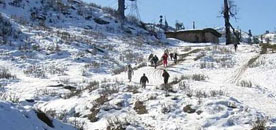
Nathatop :
One of the most popular attraction of patnitop is nathatop. Nathatop will offer you a great view of snow coated hills. Now these days nathatop is most popular due to paragliding. Hi flying from natha top will make you fill like that you are walking on the clouds. Hi flying from nathatop will provide you a good air view of surrounding peaks. Hi flying from nathatop needs a good practice of paragliding due to the reason that some times hi flying from nathatop may become a hard experience for you.
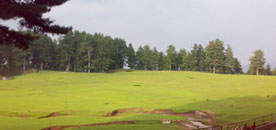
The tourist destination of Sanasar lies at a distance of 119 kilometers from the Jammu city. Kashmir Hub offers you several tours and travel options to the picturesque cup shaped meadow, Sanasar, which is surrounded by coniferous trees. Sanasar lies at a distance of 17 kilometers from Patnitop and is an ideal travel destination. Sanasar is perfect for those who are keen on spending a quite and peaceful holiday. Tourists, who travel to Sanasar and are inclined towards adventure sports, can enjoy paragliding, horse riding and camping activities. Proper paragliding training camps are organized.

Mansar lake, with its length more than a mile and width half-a-mile, is a very attractive lake in the midst of lusting greeneries surrounded by forest-covered hills. It is considered as a very holy site known from mythological periods sharing the sanctity and legacy of Mansa Sarovar. It is a very popular base of tourists. A temple for a snake god, Sheshnag, is located on the banks of lake. It is believed that it is auspicious for newly wed couples to seek blessings of Sheshnag by performing three parikarma around the lake. Holy dip in the Mansar Lake is assumed to be purifying the sins.
MAJOR ATTRACTIONS
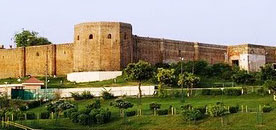
Bahu Fort :
The impressive structure Bahu Fort is amazing due to its construction itself and is the oldest fort in Jammu city. The fort renovated by rulers of Dogra in a later period, was constructed by Raja Bahulochan, nearly 300 years back. A majestic garden, known as Bagh-e-Bahu with extensive lawns beautifully filled with flowers and plants is a favorite picnic spot and surrounds the Bahu Fort. The garden has all types of attractions ranging from plants, shrubs, big trees and flowers to waterfalls. 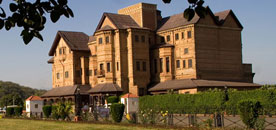
Amar Palace :
The Amar Mahal Palace is a palace in Jammu, which has now been converted into a Museum. It was built in the nineteenth century for Raja Amar Singh, a Dogra king by a French architect on the lines of a French Chateau. The palace was donated to the Hari-Tara charitable trust by Dr. Karan Singh for use as a museum. It has many exhibits including a golden throne weighing 120 kg, Pahari miniature and Kangra miniature paintings, a library of 25,000 antique books and many rare art collections. PILGRIMAGES IN JAMMU
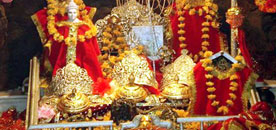
Mata Vaishno Devi :
Situated 62 km away from Jammu, Vaishno Devi shrine is located at an altitude of 1615 m above sea level. The shrine is located inside a cave on Trikuta Hills. To reach here, one has to start climbing from Katra, which is around 14 km from here. Many pilgrims cover this distance bare foot to please the Goddess and get her blessings. Inside the cave there are three rocks cut statues that represent the three Goddesses. Goddess Kali in right, Goddess Lakshmi in center and Goddess Saraswati in the left. 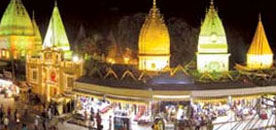
Raghunath Temple :
Maharaja Gulab Singh laid the foundation of Raghunath temple in 1853. However, his son, Maharaja Ranbir Singh, got the shrine completed in 1860. The temple, dedicated to Lord Rama, is surrounded by a number of other shrines dedicated to various Gods and Goddesses connected with the epic Ramayana. The inner walls of the main shrine are covered with gold sheet on three sides. Amongst the temples in Jammu, the Raghunath Mandir dedicated to Lord Rama, takes pride of the place, being situated right in the heart of Jammu. The temple has seven shrines, with god-plated interiors. The most important houses the Dogra's patron deity, Rama, Vishnu's eighth incarnation. 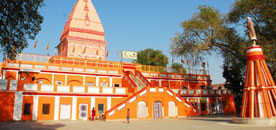
Ranbireshwar Temple :
The Ranbireshwar Temple is an important itinerary of the Jammu and Kashmir pilgrim tourism. The temple is situated on the Shalimar Road in the city of Jammu.
The temple was built by Maharaja Ranbir Singh who is one of the ancestors of the Dogra rulers of the state of Jammu and Kashmir. The temple is dedicated to Lord Shiva who is a part of the holy trinity of the Hindu mythology. The premises of the temple are divided into two halls decorated by images of the gods Ganesha and Kartikeya. 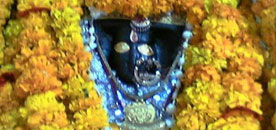
Bawey Wali Mata :
The famous temple of Bawey Wali Mata is inside the Bahu Fort where, every Tuesday and Sunday, pilgrims throng to worship the goddess. Positioned along the banks of river Tawi, the impressive construction of Bahu Fort is probably the oldest construction in Jammu. The splendid waterfalls, green terraced gardens and blooming flowers inside this fort make it one of the most peaceful forts that you would have ever witnessed. Originally built by Raja Bahulochan about 3,000 years ago.5 kms away from the central part of the city. 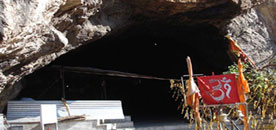
This holy cave is nearly a kilometre long and houses a 4 ft high, naturally formed 'Shivling'. It is considered second only to the shrine of Mata Vaishno Devi in religious importance. There are stalactites and stalagmites dripping milky limestone water. To the left of Shivling Mata Parwati is symbolized by impression of Her Holy feet. Kartikeya is also seen in left of Shivlingam. At nearly 2.5 feet above, five headed Ganesha is can be seen. The Holy cave has a number of other natural images which are believed to be that of 33 crores Hindu Deities.
